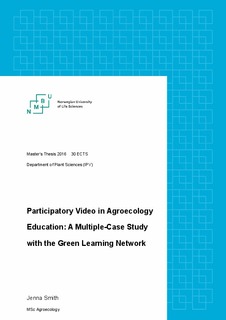| dc.contributor.advisor | Morse, Suzanne | |
| dc.contributor.advisor | Lieblein, Geir | |
| dc.contributor.author | Smith, Jenna | |
| dc.coverage.spatial | Europe | nb_NO |
| dc.date.accessioned | 2016-11-22T14:58:18Z | |
| dc.date.available | 2016-11-22T14:58:18Z | |
| dc.date.issued | 2016-11-22 | |
| dc.identifier.uri | http://hdl.handle.net/11250/2422551 | |
| dc.description.abstract | A transformation of our food system necessitates a revision of how we think and communicate about agriculture. In the past few decades, increasing attention has been paid to the unique requirements of teaching sustainable agriculture in general, and agroecology specifically. Approaches such as place-based learning, experiental learning, inquiry-learning and participatory action learning have been confirmed to enhance mastery of content as well as necessary skill development among students. In development contexts, participatory video (PV) – a participatory action research and social learning tool – has been shown to empower groups who are working for effective change within their communities. Can it then also be used to further develop the competencies of agroecology students? Might it provide a venue for extending farmer to farmer exchange? Could it offer a means of co-learning for researchers and farmers?
The present study examines the application of PV to the context of learning about agroecology to determine if PV is an effective tool for learning for both farmers and students. Three PV projects in three European countries were carried out in partnership with the Green Learning Network over the course of four months in 2015 at institutions of learning that have an emphasis on agroecological education. Participants – students, farmers and teachers – collectively designed and created their own videos about topics that were relevent to some aspect of agroecology in their communities. Through the use of questionnaires and focus-group interviews, participants' experiences and perceptions were documented and analyzed.
Results show that the PV activities enhanced communication and analytical inquiry skills, and that PV was particularly effective when used as a collaborative learning tool for the exploration of values-based aspects of agroecology. Accordingly, the most valuable aspect of PV in this study was how participants deepened their understanding of agroecology by engaging in the participatory video process. Participation in the PV activities gave way to an emergant social bridge that strengthened communities over common interests and instigated connections between people who previously were strangers. The potential for the use of PV in agriculatural extension and research is great in terms of creating shared vision and building cooperative relationships between and among farmers and researchers. Further research should examine the specific needs of stakeholders in these groups to determine how PV could be of benefit to them. | nb_NO |
| dc.language.iso | eng | nb_NO |
| dc.publisher | Norwegian University of Life Sciences, Ås | |
| dc.rights | Navngivelse-Ikkekommersiell-IngenBearbeidelse 3.0 Norge | * |
| dc.rights.uri | http://creativecommons.org/licenses/by-nc-nd/3.0/no/ | * |
| dc.subject | Agroecology | nb_NO |
| dc.subject | Participatory video | nb_NO |
| dc.subject | PV | nb_NO |
| dc.subject | Multiple-case study | nb_NO |
| dc.subject | Action research | nb_NO |
| dc.subject | Collaborative learning | nb_NO |
| dc.title | Participatory video in agroecology education : a multiple-case study with the Green Learning Network | nb_NO |
| dc.type | Master thesis | nb_NO |
| dc.subject.nsi | VDP::Agriculture and fishery disciplines: 900::Agriculture disciplines: 910::Other agricultural disciplines: 919 | nb_NO |
| dc.source.pagenumber | 96 | nb_NO |
| dc.description.localcode | M-AE | nb_NO |

